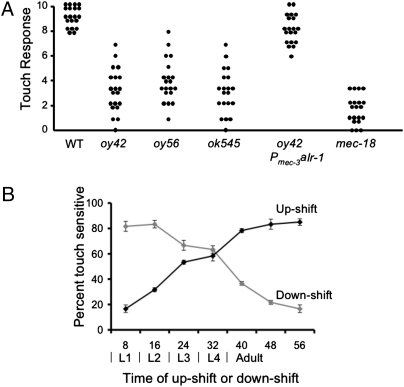Fig. 1.
ALR-1 is necessary for touch sensation, and it is needed in all stages of larval development for adult touch sensation. (A) Touch insensitivity varies in alr-1 mutants. Wild-type, alr-1(oy42) mutants rescued in the TRNs with Pmec-3 alr-1, and mec-18 mutants do not show this extreme variability. Each dot corresponds to an individual animal (n = 20). The touch response was measured as the number of times that animals moved away from 10 touches delivered alternately near the head and the tail (Materials and Methods). (B) ALR-1 is needed throughout TRN development for adult touch sensation. Temperature sensitivity of mec-8ts; alr-1 mutants, expressing MEC-8–regulated alr-1 (Palr-1 intron 9::alr-1). Temperature shifts were conducted as described previously (10): Animals were grown at the appropriate temperature for two generations and then synchronized at hatching and shifted from 15 °C to 25 °C (Up-shift, black line; at 25 °C, ALR-1 protein cannot be made) or from 25 °C to 15 °C (Down-shift, gray line; at 15 °C, ALR-1 protein can be made) at the indicated times and tested for touch sensitivity as adults. Values are the mean ± SEM of three replicates (n = 20).

